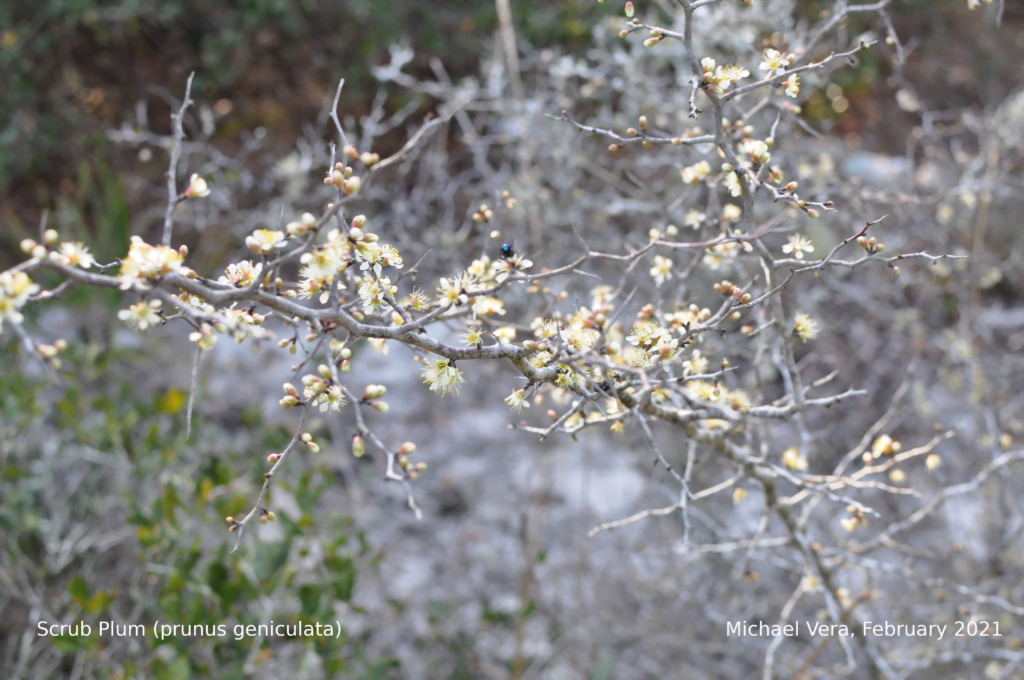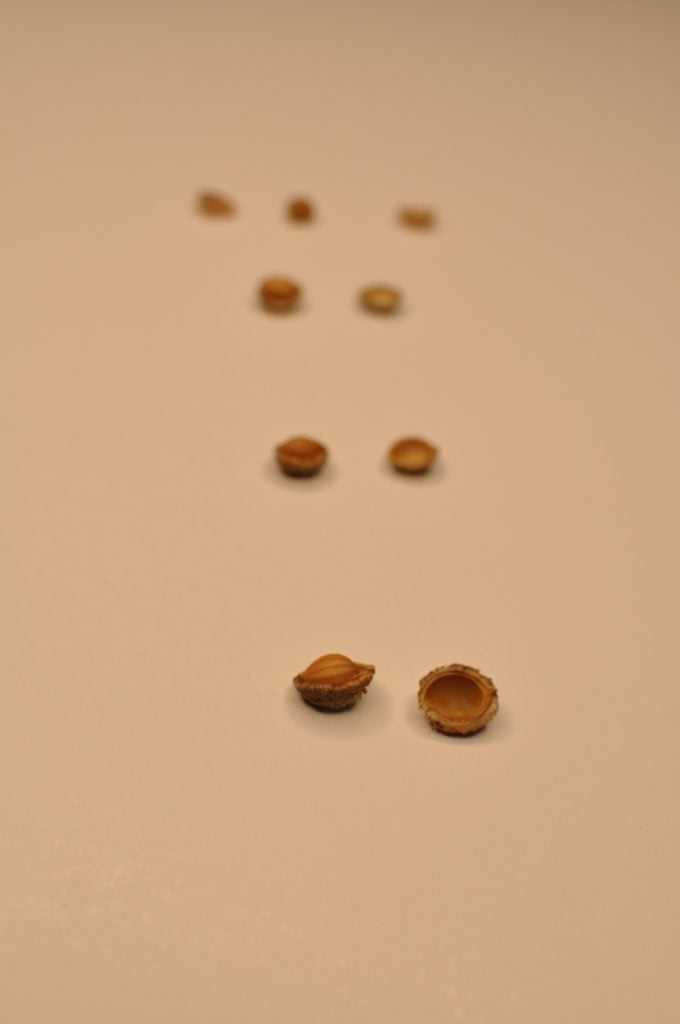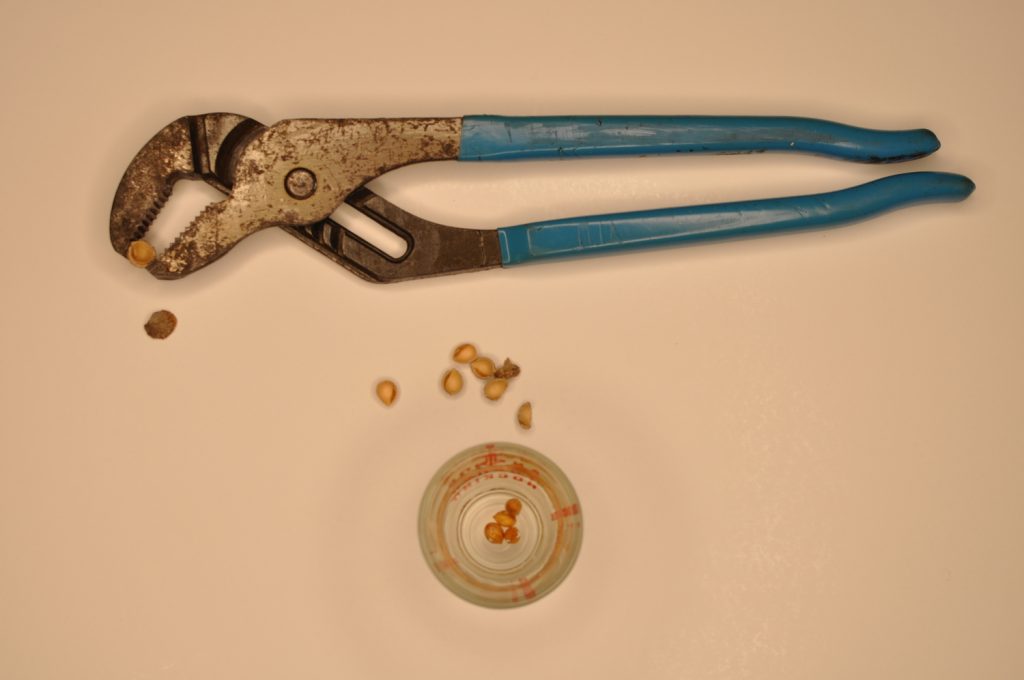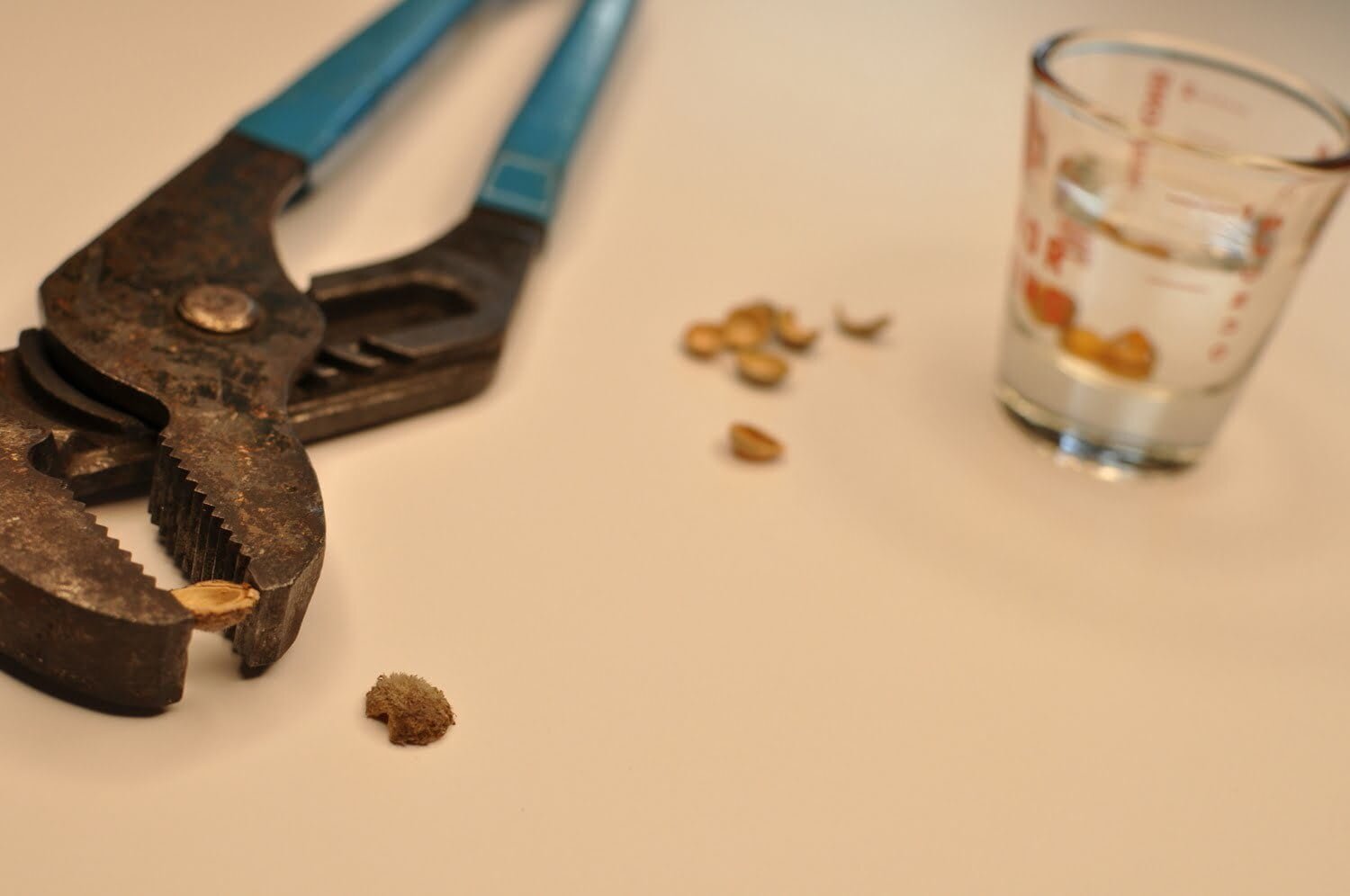The best reproductive process for any vascular plant is its most natural process, i.e. that which is interfered with least. It will be a process that takes exactly as much time as it takes, and no less. But when the mechanisms for natural seed dispersal are severed, care must be taken to intercept and recreate these mechanisms. It is usually expected that these mechanisms achieve the highest possible success rate, in order to justify the human interference. It is also understood that a one hundred percent success rate is not achievable, which allows room for error as the mechanisms are improved.
These mechanisms are even more important for those imperiled shrubs of Florida’s shrinking xeric upland. We have severed and fragmented the natural corridor of vertebrate activity, and as such, other mechanisms must exist to disperse the seeds in a manner consistent with a non-fragmented habitat.
This holds most true for the Scrub Plum (prunus geniculata) which is naturally dispersed by White-tailed Deer (odocoileus virginianus), and Gopher Tortoises (gopherus polyphemus), among other species. As long as these species are not near you, neither will there be any of the seed they would disperse.

"The scrub plum is a small shrub endemic to the oak scrub and high pine communities of the Lake Wales Ridge. The scrub plum has declined with the destruction and fragmentation of its scrub habitat for agriculture and residential housing. The scrub plum is also collected by ornamentalists because of its small, fragrant flowers. Recovery of this species will require additional surveys, land protection, and prescribed burns."
U.S. Fish & Wildlife Service Tweet
Johnny Butterflyseed has a mission to restore those endangered, threatened, rare, or underappreciated native species of the ancient ridges of Central Florida. To that end, he has acquired land specifically for the study and restoration of these endangered species. This includes a population of Scrub Plum. In concordance with The Center for Plant Conservation Best Practices for Conservation Collections, Johnny has gathered his first share of Scrub Plum drupes for the purposes of research and more importantly, restoration.

Germination Success
The first challenge to address is increasing germination rates. Previous experiments show less than 11% success.
Part of that challenge is to clear up exactly how long it takes to declare germination failure. From the perspective of typical commercial nurseries, a seed should germinate in a few days or maybe a few weeks at the most. In Florida’s xeric upland sandhill habitat, with nothing but sand for as far as the root can reach, a seed could be desiccated and stored below the surface for months and years as part of a natural seed bank. If one, of the hundreds of species that might use a Gopher Tortoise hole, carries a Scrub Plum underground, even if it does germinate after months or years, it may take months or years more for that seedling to reach the surface. Therefore, the definition of successful germination, and the definition of seedling, may need to be redefined somewhat for the Scrub Plum.
The maximum time to allow for successful germination of Scrub Plum must be considered within the context of the drupe itself. The internal Scrub Plum embryo happens to be covered by a very tough, relatively thick, very well-sealed endocarp. It is indeed a miniature prune or plum pit as one would expect to find. Johnny believes this endocarp, or its seed coat, includes specific hormones or compounds to inhibit germination, such as abscisic acid, along with the strong physical barrier to moisture it provides. That means as long as the endocarp is in place, the seed is not likely to germinate. The endocarp must go through some natural process in which it eventually breaks down, thus indicating to the embryo to sprout. But in the dry, sandy, brutal xeric uplands, a seed could wait a very long time. This problem could also apply to many endemic species which seem difficult to germinate, including Turkey Oak (quercus laevis), other prunes, hawthorns, and buckthorns. As a result, it seems impossible to impose a maximum time limit on germination success for Scrub Plum. This, then, skews results which expect success within a couple months or even a year. Had five years been acceptable, would success still be as low as 11%?
Nevertheless, Johnny Butterflyseed is not satisfied to settle for only 11% germination of his precious few drupes. Something closer to 60-80% feels better. One way to increase success would be to decrease germination time. If instead of many months or years, it could be weeks or months, it is clear germination rate would increase. It has been shown that endocarp removal can reduce germination time by half for Almond (prunus dulcis). Endocarpal removal was also able to reverse seed dormancy for Peach (prunus persica), removing the need for long stratification times. Further, the seed coat itself, while thin, may contain inhibitors to germination, such as abscisic acid as was found in the Taiwan Cherry (prunus campanulata). It remains clear, prunes all over the world may germinate more quickly, and more reliably, when the endocarp is removed.
Scrub Plum Endocarpal Removal
Johnny Butterfly believes Scrub Plum will germinate more quickly and more reliably with the endocarp removed. While it is more natural to allow germination to take as long as it needs to, for the purposes of restoring an endangered species, it seems prudent to minimize the mean germination time (MGT) and thus the time to outplanting (TTO). There have not been any published studies of germination success for prunus geniculata with the endocarp removed. The results of such a study would be beneficial, regardless of outcome, therefore Johnny will be removing endocarps from his tiny 2021 drupe supply.
Endocarpal Removal Tool
Unable to find an official Scrub Plum Endocarp Removal Tool, Johnny thought hard about what tool might both crack the shell of the drupe without crushing the embryo within. It would need to be somewhat adjustable, with the ability to restrict closing completely to avoid crushing the embryo. Simple needle-nose pliers were found to work for prunus padus in an Alaskan study, but crushed embryos about 10% of the time. The study also recommended, but didn’t try, a vise. Maybe a C-clamp would be a useful tool for endocarpal removal; its slow movement would prevent injury to the embryo.
But Johnny decided adjustable pliers would be safest, and found CHANNELLOCK® 440® 12-INCH STRAIGHT JAW TONGUE & GROOVE PLIERS provide the pressure needed, with a mechanism by which the embryo can be protected from being crushed once the endocarp cracks. Select the groove, or channel, which prevents the jaws from closing far enough to damage the embryo.

For Scrub Plums, we found the second groove is perfect, limiting the pliers’ minimum opening to 8mm. Hold the drupe with two fingers of one hand, and use the pliers to press along the drupes longest, vertical axis. Don’t be afraid to let your fingers take some of the pressure along with the endocarp; if it hurts you, it hurts the embryo, so squeeze lightly. It is also recommended to maintain a finger of the squeezing hand between the two handles to further restrict the pliers’ ability to crush.
Stop immediately when you hear the endocarp crack. You will not be able to completely separate the two endocarp halves with only the pliers. There will be a tiny split that can be pryed apart with fingernails. If a fingernail won’t quite fit into the crack, use the pliers again, along with very gentle force, to slightly open the split into which a fingernail might fit. Then pull apart directly away from each side of the split, and not with any inward force, toward the embryo.
Testing
Pre-test your endocarpal removal skills on walnuts, hazlenuts, or those pesky pistachios that haven’t been pre-cracked, and that no human can open. Remember, roasted nuts will have a more brittle embryo, so don’t be upset if your walnut splits in half or quarters. An unroasted plum embryo is quite elastic. Just master the art of pressing only enough to feel or hear a tiny split occur in the shell. Stop once you sense the slightest split; the endocarp can then be pulled apart at the split, preventing damage to the embryo.
Once comfortable with snack nuts, move on to drupes of species similar to Scrub Plum, such as Michaeux’s Hawthorne (crataegus michauxii), or Tough Bully (sideroxylon tenax), or maybe Hog Plum (ximenia americana).
After becoming comfortable with the similar species’ drupes, move on to practicing on your Scrub Plum aborts. These are drupes that never fully formed an embryo, even if the fruit appeared complete on the outside. Johnny has found endocarps under a size of 1 cm tend to be aborts. These should make excellent practice specimen before moving on to the fully-developed drupes
Johnny hopes you never crush an embryo, but if it happens, still give the little guy a chance and treat it as if it weren’t crushed. Also, there is a good chance that particular embryo was too soft as a result of a problem that happened on the bush, such as an insect that chews a tiny hole through the endocarp, allowing bacteria in to the embryo. Also, wild drupes could easily be completely crushed by grazing deer. Let’s assume we will probably improve on previous results, even with minor mistakes.
Scrub Plum Endocarpal Removal
Now that you’ve practiced on several kinds of similar drupe, its time to commence with those healthiest of drupes. These will be well over 10mm in total length of endocarp, sometimes as much as 15mm or more. Start with your largest drupes, as they should be easiest and take the most abuse. They will also be most likely to germinate.
As you can see, Johnny plops the embryo with seed coat into 500 parts per million gibberellic acid for a soak of about one day.
And while Johnny may not experience greater than 11% germination success, the odds are in his favor that he will not only experience greater germination success rates, but in a quicker turn around time than months of cold stratification, followed by many more months of slow breakdown of the endocarp.
Turning around new Scrub Plum specimens in a shorter time frame will only help the world’s Scrub Plum population, and is one of the many things Johnny Butterflyseed is doing to save endangered species.. one day at a time!
References
- https://www.fws.gov/verobeach/MSRPPDFs/ScrubPlum.PDF
- https://www.archbold-station.org/documents/plants/Weekley_et_al_Seedling_rarity_in_scrub_plum_2010.pdf
- http://www.plantarchives.org/20-2/8347-8352%20(7122).pdf
https://cfs.nrcan.gc.ca/pubwarehouse/pdfs/32409.pdf - https://www.sciencedirect.com/science/article/abs/pii/S0304423803001171
- https://www.cambridge.org/core/journals/seed-science-research/article/abs/dormancybreak-and-germination-in-seeds-of-prunus-campanulata-rosaceae-role-of-covering-layers-and-changes-in-concentration-of-abscisic-acid-and-gibberellins/1647EB05B8D969E20E6024E201DB5FA1
- https://accs.uaa.alaska.edu/wp-content/uploads/Viability_of_European_Bird_Cherry_seeds.pdf
- https://channellock.com/product/440/
